Figures & data
TABLE I Endogenous Variables in CPLEX Model
TABLE II Exogenous Variables in CPLEX Model
TABLE III Exogenous Variable Input Values for Various Power Plant Types
Fig. 1. Projected demand curve for peak summer and winter demand over 20-year period from IESO’s 2021 annual planning outlook.[Citation6]
![Fig. 1. Projected demand curve for peak summer and winter demand over 20-year period from IESO’s 2021 annual planning outlook.[Citation6]](/cms/asset/63d24e3a-80a4-4f89-8588-104d725ae771/unct_a_2217390_f0001_oc.jpg)
Fig. 2. CANDU reactor refurbishment and decommissioning schedule.[Citation6]
![Fig. 2. CANDU reactor refurbishment and decommissioning schedule.[Citation6]](/cms/asset/d3eef45d-530b-438b-b6ad-01030c5792c7/unct_a_2217390_f0002_oc.jpg)
Fig. 3. Optimized 2055 energy mix with (a) GE Hitachi candidate SMR introduction and (b) NuScale iPWR candidate SMR introduction.

Fig. 4. Proportionate contributions to the average hourly load in the final model instance of the optimized scenario.

Fig. 5. IESO’s evaluation of Ontario’s energy adequacy given existing capabilities.[Citation6]
![Fig. 5. IESO’s evaluation of Ontario’s energy adequacy given existing capabilities.[Citation6]](/cms/asset/fb47d52e-f4ab-40bf-b9ba-8e1f8bdc1fa0/unct_a_2217390_f0005_oc.jpg)
Fig. 6. Optimized 2055 installed capacities with (a) GE Hitachi candidate SMR introduction and (b) NuScale iPWR candidate SMR introduction.

Fig. 7. Evaluation of energy adequacy of Ontario’s accumulative energy output in optimized GE Hitachi SMR scenario.

Fig. 8. Comparison of the growing average demand alongside the OBJ values for the GE Hitachi and no-SMR optimized scenarios. A trendline is included to compare the GE Hitachi OBJ values with a linear trend.

Fig. 9. Optimized 2055 no-SMR scenario: (a) installed capacity values and (b) accumulative energy output.

Fig. 10. Comparison of scenario OBJ values over time. The NuScale (NS) and GE Hitachi (GE) lines are too close to distinguish.

Fig. 11. Comparison of OBJ values of new GE Hitachi SMR scenario with no starting capacity (blue) and an initial investment of 2 GW into SMR capacity (orange). Agreeable results were found for a NuScale-based scenario.

Fig. 12. Various projected learning curves corresponding to approximate costs at 0 GW installed (FOAK) and 10 to 16 GW installed (NOAK). For this case, existing CANDU capacity has been ignored.[Citation4,Citation5,Citation33,Citation36,Citation37]
![Fig. 12. Various projected learning curves corresponding to approximate costs at 0 GW installed (FOAK) and 10 to 16 GW installed (NOAK). For this case, existing CANDU capacity has been ignored.[Citation4,Citation5,Citation33,Citation36,Citation37]](/cms/asset/a46e64f0-2d00-4a6f-92af-ab1584aa47ee/unct_a_2217390_f0012_oc.jpg)
Fig. 13. A comparison of the installed capacity values for SMRs versus CANDU reactors when (a) varying the total variable cost (fuel and variable O&M combined) and (b) varying the total fixed cost (OCC and fixed O&M combined).[Citation4,Citation5,Citation33,Citation36,Citation37]
![Fig. 13. A comparison of the installed capacity values for SMRs versus CANDU reactors when (a) varying the total variable cost (fuel and variable O&M combined) and (b) varying the total fixed cost (OCC and fixed O&M combined).[Citation4,Citation5,Citation33,Citation36,Citation37]](/cms/asset/5204746a-29b6-48f2-9802-7d42dce36e7d/unct_a_2217390_f0013_oc.jpg)
Fig. 16. Accumulative energy output from 2.5% annual increasing demand scenario. As expected, the resulting SMR output increased dramatically.

Fig. 17. Accumulative energy output from static load scenario. Without the increasing demand, it follows that SMR usage should be reduced overall, acting only to replace more expensive plant types.

Fig. 18. Projected accumulative energy output from high SMR cost scenario (100% increase). With the significant increase in associated costs, SMRs are no longer effective in the economically optimized model.

Fig. 19. Projected accumulative energy output from 50% SMR cost increase scenario. SMR usage has dropped significantly in lieu of CANDU use, though it is still viable to a small degree.

Fig. 20. Sensitivity analysis of the effect of varying fixed and variable SMR cost values on installed SMR capacity. Costs are represented as a fractional percentage of the original fixed and variable costs used in the optimized scenario, and the installed SMR capacity surpassed 1 GW at 177.6%, or a 77.6% increase from the original values.

TABLE A.I Input Values for Model Constants


